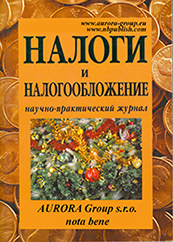ARBITRATION COURT PRACTICE OF TAX DISPUTE RESOLUTION
Reference:
Osina, D. (2018). Consequences of Applying Incorrect Value-Added Tax Rate by Parties. Taxes and Taxation, 4, 1Ц6. https://doi.org/10.7256/2454-065X.2018.4.26096
Abstract:
Basaed on the analysis of the position of the Supreme Court of Russia regarding a relevant case, the author of this article analyzes consequences of applying incorrect value-added tax rate by parties. In particular, the author focuses on the following issues: 1) the scope of the contractual judgement made by parties when concluding a treaty; 2) whether presentment of VAT payable can be considered to be an alteration of a treaty; and 3) consequences of applying the zero tax rate instead of a 18 % rate, and vice versa. Osina bases her research on a detailed analysis of tax and civil laws as well as positions of supreme judicial authorities. Based on the results of the research, the author concludes that in fact the position of the Supreme Court of Russia regarding the matter creates contradictions in VAT taxation regimes under the same treaty. Moreover, related issues regarding a buyer's opportunity to apply for VAT to be deducted from a sum payable is left uncovered by the Supreme Court and so is the question about the actual amount of tax liability of a seller. This creates gaps in the tax law and may provoke judicial disputes.
Keywords:
Scope of discretion of parties, Change of price, Civil code of Russia, Tax Code of Russia, Peremptory rules, VAT recovery from counterparty, Supreme Court of Russia, Incorrect rate, Value-added tax, Indirect nature of VAT
TAXATION OF PHYSICAL PERSONS
Reference:
Ksiropulos, I.D. (2018). Criteria for Classification of Beneficiaries of Social Tax Benefits. Taxes and Taxation, 4, 7Ц17. https://doi.org/10.7256/2454-065X.2018.4.25928
Abstract:
The subject of the research is the classification of recipients of social tax benefits, the object of the research is the social tax benefits granted to beneficiaries in accordance with the classification of recipients of tax benefits offered by the author of the article. In this article Ksiropulos examines such aspects of the topic as the social support of population through applying tax instruments, in particular, personal income tax benefits. The author pays special attention to the decrease of the level of social dependency by using tax benefits, in particular, withdrawal of employable citizens from the category of poor individuals to the category of self-sufficient individuals. The theoretical and methodological basis of the research includes legal acts of the Russian Federation issued in the field of social welfare as well as tax regulation of profits of physical entities and socially oriented organisations. The scientific novelty of the research is caused by the fact that the author offers a classification of recipients of social support for taxation purposes and defines criteria for selecting tax benefits depending on beneficiaries in accordance with the principals of them being transferred to the category of self-sufficient individuals as well as creation of certain 'target' conditions for granting tax benefits, in particular, lowering the level of social dependency.
Keywords:
tax policy, charity, business entities, tax mechanism, tax instruments, social support, Beneficiary of social tax benefits, poor families, self-sufficiency, social dependency
TAX SYSTEMS OF THE FOREIGN STATES
Reference:
Ryzhkova, E.A. (2018). Legal Regulation of VAT in Saudi Arabia. Taxes and Taxation, 4, 18Ц25. https://doi.org/10.7256/2454-065X.2018.4.26211
Abstract:
The article is devoted to the analysis of the legal regulation of a new tax for Saudi Arabia - value-added tax that was introduced in the Kingdom of Saudi Arabia on January 1, 2018. Even though indirect taxation is widely used in the modern world, it had never been common for Middle Eastern Countries as a result of particular features of the fair taxation principle in these countries. The author of the article analyzes economic and historical prerequisites for introducing VAT in Saudi Arabia and studies the main elements of tax. In the course of analyzing the legal grounds for introducing VAT in the Kingdom of Saudi Arabia, the author has used formal law, historical law, and comparative law methods. The scientific novelty of the research is caused by the object research, i.e. Saudi Arabia, as one of the first states of the Cooperation Council for the Arab States of the Gulf that implements the principles of the Single Agreement for Value-Added Tax issued by The Cooperation Council for the Arab States of the Gulf. The author's contribution to the topic is the conclusion that Saudi Arabia does not only take into account the experience of the foreign states in regulation of tax relations but also to preserve Islamic taxation traditions including the fair taxation principle which was reflected in the description of the main elements of VAT.
Keywords:
VAT refund, GAZT, principle of justice, Muslim taxes, VAT, Saudi Arabia, Value Added Tax Law, GCC, indirect taxation, Zakat
Question at hand
Reference:
Chapkina , N.A. (2018). Assessing Efficiency of Control Activities of the Federal Tax Service of Russia for 2013 - 2017. Taxes and Taxation, 4, 26Ц39. https://doi.org/10.7256/2454-065X.2018.4.26342
Abstract:
The subject of the research is the efficiency of control activities of the Federal Tax Service of Russia. The object of the research is the activity of the Federal Tax Service of Russia devoted to control (supervision) of taxes and levies. The author of the research examines tax control issues, in particular, tax inspections. The author pays special attention to analyzing efficiency of activities performed by the Federal Tax Service of Russia and gives an assessment of efficiency of tax inspections and audits. The author provides data regarding additional charges and points out new systems of control that influenced the dynamics of revenues. The author also touches upon the question about tax crime and gives results of interdepartment interaction between the Federal Tax Service of Russia and Russian Investigative Committee. The author analyzes changes in the Criminal Code of the Russian Federation in 2017 regarding tax crime. In her research the author used such methods as integral analysis, comparison, and empirical methods such as deduction. The main result of the research is the activities and measures offered by the author to increase efficiency of tax control. The author's special contribution to the topic is her analysis of definitions of 'tax control' given by researchers and detailed analysis of efficiency of control activities of the Federal Tax Service of Russia over the past 5 years. The novelty of the research is caused by the author's definition of 'tax control'.
Keywords:
additional charges, liability, evasion, crime, violation, tax control, tax, criminal code, tax code, budget
LEGAL REGULATION OF TAX RELATIONS
Reference:
Steshenko, Y.A. (2018). Classification of Branches of National Economy Depending the Level of Clasterization-Based Tax Incentives. Taxes and Taxation, 4, 40Ц57. https://doi.org/10.7256/2454-065X.2018.4.25933
Abstract:
Efficient tax incentives used to encourage the development of economic sectors may contribute to the economic growth as well as ensure social, economic and budget stability. This article is devoted to the issues of sectorial tax incentives. The author of the article examines peculiarities of modern taxation from the point of view of national economy branches and particular economic activities. Steshenko carries out an analysis of existing elements of tax incentives. According to the author, at the present stage of economic development the most nettlesome problem is the choice of targets for sectorial tax incentives within the existing taxation system. The methodological basis of the research is the fundamental concepts presented by Russian researchers and systematic analysis of tax laws and regulations. In the course of the research Steshenko has used statistical modelling, historical, graphic and multivariate statistics methods that allowed to view the process of sectorial tax incentives from the point of view of their classification. The novelty of the research is caused by the fact that the author offers a classification of national economy branches depending on their clasterization and efficiency of tax incentives using the multivariate statistics method. The author also discovers and theoreticall substantiate three clusters as well as make recommendations on how to choose targets for sectorial tax incentives based on their peculiarities.
Keywords:
research and development, effectiveness, cluster analysis, typology, efficiency, branches of national economy, tax incentives, investment activity, tax, tax break
ORGANIZATION AND METHODS OF TAX CONTROL
Reference:
Tonkikh, A.S., Trushin, I.I. (2018). Developing the Economic Expediency Criterion for Pre-Trial Analysis of Taxpayers. Taxes and Taxation, 4, 58Ц73. https://doi.org/10.7256/2454-065X.2018.4.26092
Abstract:
The subject of the research is the process of selecting corporate taxpayers (enterprises) for on-site inspections. The object of the research is a corporate taxpayer (enterprise). The aim of the research is to develop the economic expediency criterion that, when being violated, could be used as an alarm to plan an on-site inspection. The research method is the construction of dynamic standards, i.e. simultaneous inequalities that arrange various indicators (including non-homogenous) in order depending on their pace of growth. Dynamic standards are based on corporate economics patterns and present the best organizational mode for an enterprise which can be taken as the economic expediency criterion. Ranking enterprises depending their compliance to this criterion can be viewed as a desired one to be used in the process of selecting taxpayers for on-site inspections. As a result of their research, the authors offer their own method of selection of corporate taxpayers (enterprises) for on-site inspections depending on the economic expediency criterion, and make a list of major Russian stevedoring companies for on-site inspectios. The scope of the application of these results covers the following: planning the sequence of corporate taxpayers that require on-site inspections by the tax authorities according to the econolmic expediency criterion; and discovery of hidden trends in corporate economics that may be used as alert indicators to be used for the purpose of tax optimization.
Keywords:
stevedore companies, economic indicators, tax audits, planning of on-site inspections, business laws, economic expediency, dynamic standards, pre-test analysis, rates of growth, dynamics of indicators
PREDICTION AND PLANNING IN TAXATION
Reference:
Popova, E.M. (2018). Using the Marginal Tax Rate Model for Evaluating the Tax Burden on Fixed Asset Investments in Russia's Economy. Taxes and Taxation, 4, 74Ц90. https://doi.org/10.7256/2454-065X.2018.4.25929
Abstract:
One of the most important prerequisite for an efficient policy of both the state and private company is the availability of instruments to carry out an integral evaluation of an controlled object. Thus, the subject of this article is the analysis of potential of the marginal tax rate model for evaluation of the tax burden on fixed asset investments from the point of view of different branches of economy. The main purpose of the research initiated by the author is to carry out a comparative analysis of an expected tax burden depending on different sectors and assets of Russia's economy. The research is based on the use of such formal logic methods as induction, deduction, synthesis, analysis and comparison. The aforesaid methods allowed to define the scope of application of the marginal tax rate model. For example, it can be used as a methodological basis for evaluating the influence of tax policy on the level of taxation of different sectors and assets. The scientific novelty of the research is caused by the fact that unlike previous estimations made by Russian economicsts, the tax burden on real investments were assessed for a wide range of economic activities and the burden matrices were drawn out depending on the depreciation method used for tax purposes. In addition, the amount of the tax burden was compared to the actual investment behavior of a sector. From the point of view of increasing the tax burden, transport, communication and trade are most attractive sectors for investments and construction, agriculture, fish breeding and fishing industry are the least attractive. The results of the research are coherent with the indicators of investment activity: construction, agriculture and fishing industry have the lowest pace of investment growth.
Keywords:
discount rate, rate of return, asset, investment, depreciation, tax shelter, cost of capital, debt, marginal tax rate, tax burden
 This work is licensed under a Creative Commons Attribution-NonCommercial 4.0 International License.
This work is licensed under a Creative Commons Attribution-NonCommercial 4.0 International License.
 Eng
Eng












 © 1998 Ц 2025 Nota Bene. Publishing Technologies. NB-Media Ltd.
© 1998 Ц 2025 Nota Bene. Publishing Technologies. NB-Media Ltd.




